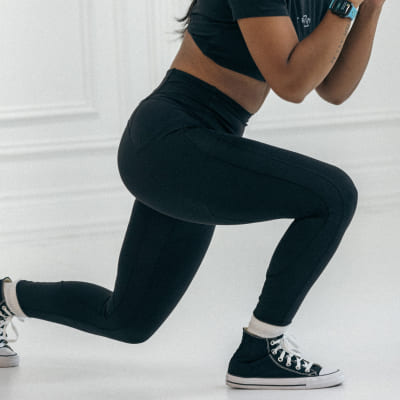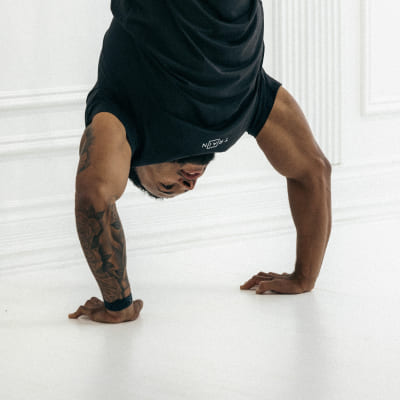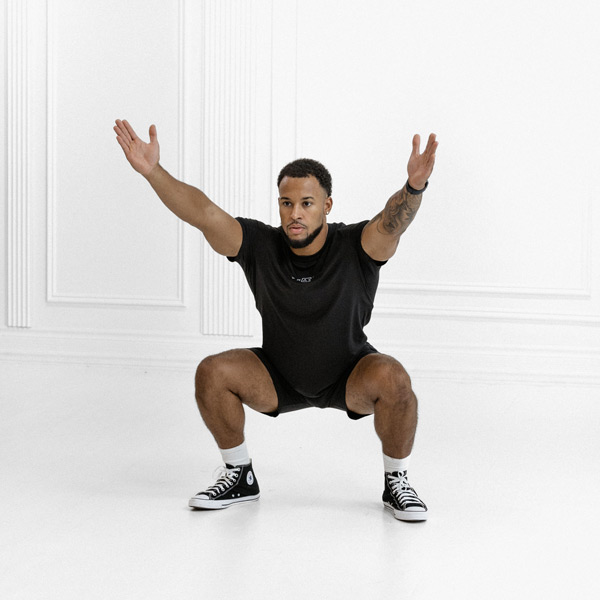
Video Coming Soon
We're working on adding video demonstrations for this exercise.
TRX Squat to Y Fly
TRX Squat to Y Fly combines a supported squat with a Y-shaped arm raise using suspension straps, targeting quads, glutes, shoulders, and upper back to build full-body strength and stability.
About Exercise
Equipment
Bands, Others
Difficulty
3/5 • Intermediate
Primary Muscle Groups
Quads, Shoulders
Secondary Muscles
Abs, Obliques, Lower Back
Popularity Score
6
Goals
Training Style
Setup Requirements
Requires Rack
No
Requires Bench
No
Requires Spotter
No
Space Needed
Small
Noise Level
Low
Muscle Breakdown
View Muscle MapQuads
8/10Rectus Femoris, Vastus Lateralis, Vastus Medialis
Shoulders
8/10Rear Delts
Glutes
7/10Glute Max
Traps
7/10Upper Traps, Lower Traps
Hamstrings
6/10Biceps Femoris
Abs
5/10Rectus Abdominis
Obliques
4/10External Obliques
Lower Back
4/10Erector Spinae
Programming
Typical Rep Range
8-15 reps
Rest Between Sets
60-90 seconds
How to Perform
Adjust TRX straps to mid-length. Stand facing anchor, grip handles with overhand grip, step back to create tension and slight lean, feet shoulder-width apart, arms extended forward at shoulder height, core engaged.
- Lower into squat by pushing hips back and bending knees, keeping arms straight and extended forward.
- Maintain plank-like body position with weight on heels.
- Drive through heels to stand up, simultaneously raising arms overhead into Y shape.
- Squeeze shoulder blades together at top.
- Control arms back to shoulder height as you lean slightly.
- Repeat for reps, keeping core tight.
Coaching Tips
Form Cues
- Keep core engaged
- Arms straight throughout
- Weight on heels
- Squeeze shoulder blades
- Maintain diagonal body line
- Knees track over toes
Breathing
Inhale during descent into squat and arm lower; exhale as you drive up and raise arms.
Tempo
3-1-1
Range of Motion
Squat until thighs parallel to ground; raise arms to form Y overhead with slight elbow bend, body in straight line.
Safety
Safety Notes
- Verify TRX anchor security
- Avoid if acute shoulder or knee pain
- Adjust lean for ability level
- Stop if dizziness occurs
- Use shallower squat if hip mobility limited
- Maintain neutral spine to protect lower back
Spotting
Not required; self-supported bodyweight exercise, but partner can assist with form cues if needed.
Common Mistakes
- Knees caving inward
- Arched back or sagging hips
- Jerky arm movements
- Incomplete squat depth
- Slack in straps
- Leaning too far forward
When to Avoid
- Acute shoulder impingement
- Knee joint instability
- Lower back strain
- Poor balance or dizziness
Flexibility Needed
- Adequate ankle dorsiflexion for squat
- Shoulder flexion to 160 degrees
- Hip flexion without compensation
Build Up First
- Basic squat technique
- Familiarity with TRX handling
- Core bracing proficiency
Also known as
TRX Y Fly Squat, Suspension Squat Y Raise, TRX Squat Y Raise
Found this helpful?
Share your thoughts or help us improve this guide.
Similar Exercises

TRX Split Squat
Others
Quads

Resistance Band Y-Fly
Bands
Shoulders

TRX T-Deltoid Fly
Others
Shoulders

TRX W-Deltoid Fly
Others
Shoulders

TRX Cossack Squat
Others
Quads

TRX Overhead Squat
Others
Quads

TRX Y-Deltoid Fly
TRX
Shoulders

TRX Single-Leg Squat
Others
Quads

Y Squat
Bodyweight
Quads

Resistance Band Squat to Press
Bands
Quads, Shoulders


subscribe to our newsletter
Contact Us
hello@trainfitness.aiFind Us
130 Spadina Avenue, Toronto,
Ontario, M5V 0H4, Canada
©2025 All Rights Reserved
